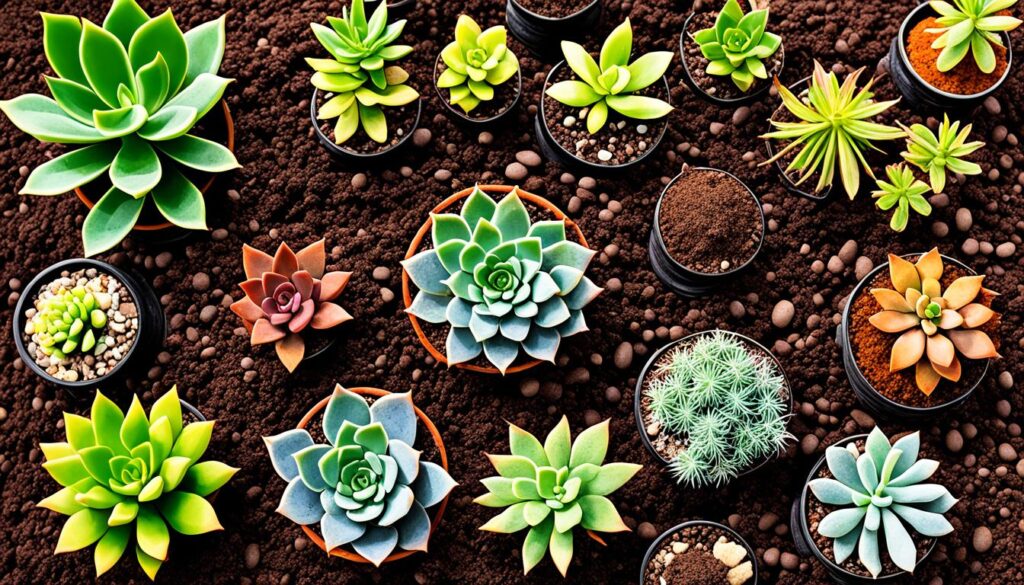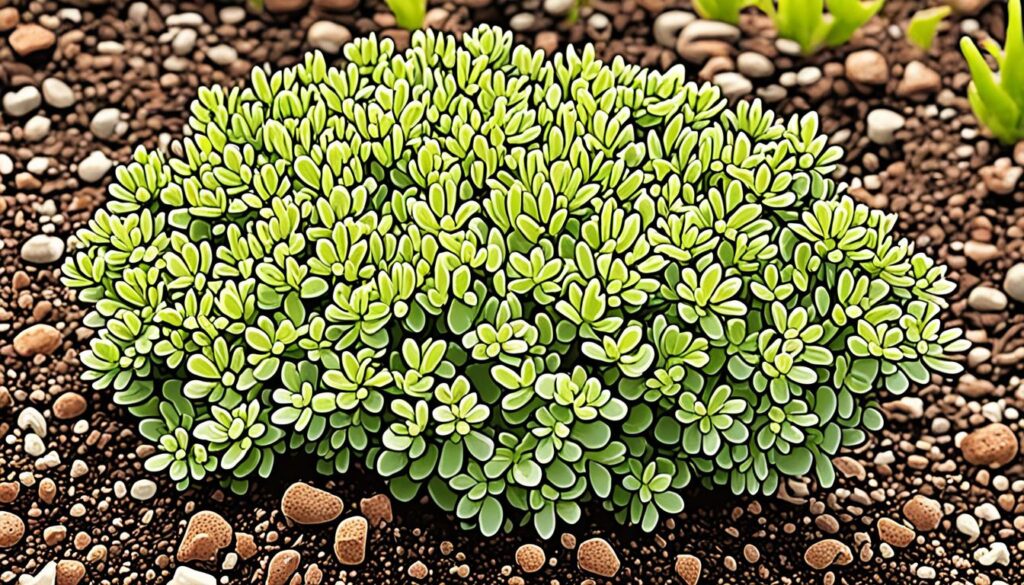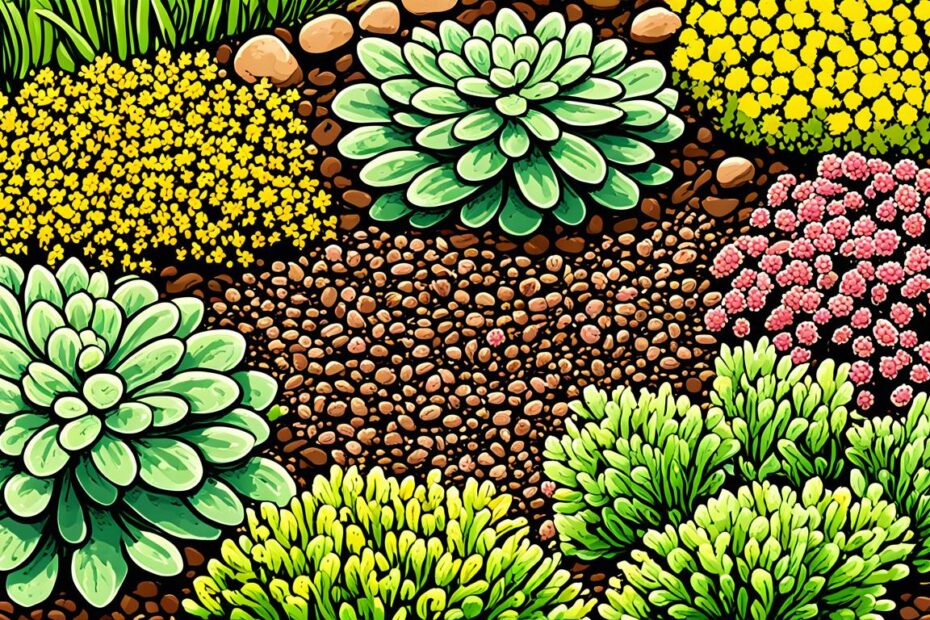Are you struggling to get your sedum plants to thrive? Do they seem to always be struggling, with lackluster growth and wilting leaves? The problem might just lie in the soil you’re using. But what is the best soil for sedums to ensure optimal growth and vibrant, healthy plants?
Succulent plants, like sedums, have specific needs when it comes to soil. They require a soil mix that promotes excellent drainage, prevents root rot, and provides the right level of nutrients. By understanding the ideal soil composition for sedums, you can create an optimal growing environment that will allow your sedums to flourish.
Key Takeaways:
- Choosing the right soil is essential for the healthy growth of sedum plants.
- Succulent plants, including sedums, have specific soil requirements due to their adaptation to arid conditions.
- The best soil for sedums should be well-draining, well-aerated, and have minimal nutrient content.
- Using a mix of organic matter and inorganic materials helps create the ideal soil composition for sedums.
- Commercial potting mixes designed for succulents are also a convenient option for sedum growth.
What is a Succulent Plant?
Succulent plants, including sedums, are a fascinating group characterized by their unique plant adaptations. They possess thick and fleshy leaves or stems that store water, enabling them to survive in arid conditions with minimal care. These succulent adaptations make them a popular choice for both indoor and outdoor gardens.
Specifically, sedums are known for their diverse range of species and remarkable plant adaptations. These adaptations allow sedums to thrive in various environments and make them well-suited for garden enthusiasts of all levels of experience.
“Succulent plants are nature’s resilient wonders, with their ability to survive in dry climates and store water in their juicy leaves and stems. Sedums are no exception, showcasing a wide array of species with unique adaptations that make them prized additions to any garden.”
To create the best growing conditions for sedums, it is essential to understand their characteristics and unique plant adaptations. This knowledge will enable you to provide them with the optimal care and environment to thrive.
Characteristics of Succulent Plants:
- Drought-resistant: Succulents have evolved to survive in dry environments by storing water in their leaves or stems.
- Thick and fleshy leaves or stems: These adaptive structures allow succulents to store sufficient water for extended periods.
- Reduced leaf surface area: Succulents often have small, thick leaves or modified stems to minimize water loss through evaporation.
- Succulent adaptations: These adaptations vary between species but generally involve water storage, efficient water use, and reduced transpiration rates.
Understanding these plant adaptations is crucial for providing succulents, including sedums, with the right growing conditions. By recreating their natural habitats, you can ensure the health and thriving growth of these beautiful plants.
The Best Soil for Succulents
Sedums, like all succulents, have unique soil requirements that differ from other plants in your garden. To ensure the best soil for succulents, it is important to consider their specific needs, such as well-draining soil that prevents excessive moisture retention and promotes healthy root growth. Additionally, succulent potting mix should provide adequate aeration and contain minimal nutrients to avoid over-fertilization.
Mixing organic matter, such as compost or peat moss, with inorganic materials like sand or pumice can help create the ideal soil composition for sedums. The organic matter improves water retention, while the inorganic materials enhance drainage. Finding the perfect balance is key to creating the optimal soil environment for these resilient plants.
Succulent Soil Requirements:
- Well-draining soil to prevent root rot
- Adequate aeration for healthy root growth
- Minimal nutrient content to avoid over-fertilization
By meeting these soil requirements, you can ensure that your succulents, including sedums, thrive in your garden. Creating the ideal soil mix not only aids in their growth but also helps maintain their natural resilience and beauty.

| Component | Description |
|---|---|
| Organic Matter | Improves water retention capacity |
| Inorganic Materials | Enhances soil drainage |
Recommended Soil Mix for Sedums
When it comes to growing sedums, choosing the right soil mix is essential for their optimal growth and overall health. The ideal sedum soil should be porous and well-drained, allowing water to flow through quickly and preventing waterlogged conditions. By providing the perfect balance of moisture and aeration, this recommended soil mix ensures that your sedum plants thrive.
To create the ideal sedum planting mix, start with a base of regular potting soil. This provides a solid foundation while allowing for good drainage. To further enhance drainage, incorporate sand or perlite into the mix. These materials effectively loosen the soil and promote water movement. Remember, proper drainage is key to preventing root rot and other moisture-related issues.
Another crucial aspect of the recommended sedum soil mix is the addition of organic matter. Compost or peat moss can be mixed in to improve the water retention capacity of the soil. This ensures that your sedums receive adequate moisture during dry periods. In addition, organic matter provides essential nutrients that nourish the plants, promoting healthy growth and vibrant colors.
Choosing the right soil mix is crucial for the successful growth of sedums. A combination of organic and inorganic materials creates an ideal environment that allows these beautiful succulents to thrive.
Commercial potting mixes designed specifically for succulents are also available and offer a convenient option for sedum planting. These mixes are formulated with the ideal combination of ingredients, catering to the specific needs of succulent plants like sedums. Consider using a commercial mix to save time and ensure consistent results.
Here is a summary of the recommended soil mix for sedums:
| Ingredient | Purpose |
|---|---|
| Regular potting soil | Provides a solid base and allows for good drainage. |
| Sand or perlite | Improves soil drainage by loosening the texture. |
| Compost or peat moss | Enhances water retention capacity and provides necessary nutrients. |
Remember to choose a soil mix that meets these criteria to ensure successful growth and thriving sedum plants in your garden. With the right soil, your sedums will flourish and add a touch of natural beauty to your outdoor space.

Conclusion
Creating the best soil for sedums is crucial for their optimal growth and overall health. By understanding the unique soil requirements of succulents, such as sedums, and choosing the right soil mix, you can provide them with the ideal growing conditions.
Well-draining, porous soil with adequate aeration and minimal nutrient content is key to prevent issues like root rot and promote vigorous sedum growth. Consider the recommended soil mix options mentioned in this article to create a thriving garden sanctuary with vibrant sedums.
With the right sedum soil, you can maximize the beauty of your garden and enjoy the benefits of these stunning succulents. Remember to provide proper care, such as regular watering and proper sunlight, to ensure the best growth for your sedum plants. Happy sedum gardening!
FAQ
Why is soil important for sedum growth?
The right soil provides the necessary drainage and aeration for sedums to thrive, preventing issues like root rot and promoting healthy growth.
What type of soil is best for sedums?
The best soil mix for sedums should be well-draining and porous, with minimal nutrients. It can be a combination of regular potting soil, sand or perlite, and organic matter like compost or peat moss.
Can I use regular garden soil for sedums?
Regular garden soil is generally not suitable for sedums as it lacks the proper drainage and nutrient levels. It is recommended to use a specialized succulent potting mix or create a custom mix with the right components.
How often should I water sedums?
Sedums are drought-tolerant plants and should be watered sparingly. Allow the soil to dry out between waterings, and water only when the top inch of the soil feels dry to the touch. Overwatering can cause root rot.
Can I use sand alone as a soil mix for sedums?
Sand alone is not recommended as it does not provide sufficient organic matter or nutrients for sedum growth. It is best to mix sand with regular potting soil or other components to create a balanced soil mix.
Can I use cactus soil for sedums?
Yes, cactus soil can be a suitable option for sedums, as it is specifically formulated with good drainage and low nutrient content. However, it is still recommended to mix it with other components like sand or perlite for better results.
